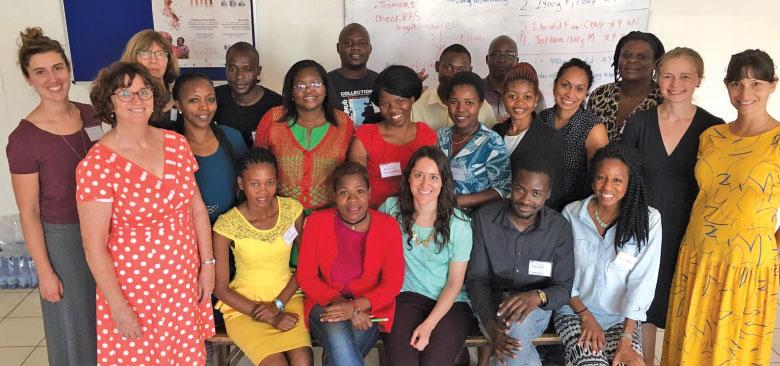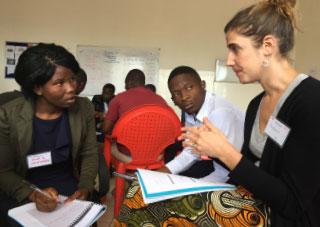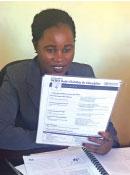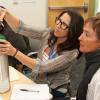
Participants in the 2017 UCSF GAIN training in Malawi at Neno District Hospital. Stephanie Kennell-Heiling is far left.
An Extraordinary Learning Experience Helping Make Childbirth Safer in Malawi
According to the World Health Organization (WHO), “Of the more than 130 million births occurring each year, an estimated 303,000 result in the mother’s death, 2.6 million in stillbirth, and another 2.7 million in a newborn death within the first 28 days of birth. The majority of these deaths occur in low-resource settings and most could be prevented.”
In response, the WHO developed its Safe Childbirth Checklist (SCC), which addresses the major causes of maternal death, intrapartum-related stillbirths and neonatal deaths. The SCC was a first step, but to ensure that the essential childbirth practices it describes become the standard of care in settings around the world, providers have had to develop ways to encourage implementation in each unique setting.
 Kennell-Heiling and participants in the 2017 UCSF GAIN training discuss the characteristics of a good nursing leader. In Malawi, the need is particularly acute, because the African country has one of the world’s highest maternal mortality rates, according to the United States Agency for International Development (USAID). That’s why, in the summer of 2017, I came to be working on a maternal health collaboration in Malawi designed by the UCSF School of Nursing Center for Global Health and the nonprofit organization Partners in Health, called the Global Action in Nursing (GAIN) Initiative. My role in this collaboration – working with Kimberly Baltzell, director of the School’s Center for Global Health – was part of my Project Planning course at the School, a standard requirement in which students implement an evidence-based test of change in a clinical setting. My task was to design the best visualization format of the WHO SCC and adapt it to Neno District Hospital and surrounding health centers in this remote area of southern Malawi.
Kennell-Heiling and participants in the 2017 UCSF GAIN training discuss the characteristics of a good nursing leader. In Malawi, the need is particularly acute, because the African country has one of the world’s highest maternal mortality rates, according to the United States Agency for International Development (USAID). That’s why, in the summer of 2017, I came to be working on a maternal health collaboration in Malawi designed by the UCSF School of Nursing Center for Global Health and the nonprofit organization Partners in Health, called the Global Action in Nursing (GAIN) Initiative. My role in this collaboration – working with Kimberly Baltzell, director of the School’s Center for Global Health – was part of my Project Planning course at the School, a standard requirement in which students implement an evidence-based test of change in a clinical setting. My task was to design the best visualization format of the WHO SCC and adapt it to Neno District Hospital and surrounding health centers in this remote area of southern Malawi.
To better understand the setting, I traveled to Neno District and participated in a two-week training to learn and practice the skills outlined in the WHO SCC alongside 15 Malawian midwives from eight different health facilities. It was a privilege to watch these nurses in action and observe the places where they delivered clinical care. Then, based on a literature review, on-site training and input from all 15 nurse-midwives, we decided that the best visual format for the SCC would be a poster. It would allow nurse-midwives, who often work independently, to have a hands-free reference as they care for the mother and baby.
 A Malawian midwife reviews documents during the 2017 GAIN training. With the insight from my Malawian colleagues and my own clinical observation, I quickly realized that the facilities had different architectural layouts, which affected where a nurse-midwife would perform a particular intervention. As the WHO SCC has four pause points – on admission, just before pushing (or cesarean), soon after birth (within one hour) and before discharge – one nurse-midwife might perform all four pause points in one room, while another might perform pause points one and two in one area and complete the final pause points in a different location. In order to create a uniform design that was applicable to all settings, we decided to create four smaller posters, one for each pause point, which enables the midwives to place the posters where they work best in each particular setting.
A Malawian midwife reviews documents during the 2017 GAIN training. With the insight from my Malawian colleagues and my own clinical observation, I quickly realized that the facilities had different architectural layouts, which affected where a nurse-midwife would perform a particular intervention. As the WHO SCC has four pause points – on admission, just before pushing (or cesarean), soon after birth (within one hour) and before discharge – one nurse-midwife might perform all four pause points in one room, while another might perform pause points one and two in one area and complete the final pause points in a different location. In order to create a uniform design that was applicable to all settings, we decided to create four smaller posters, one for each pause point, which enables the midwives to place the posters where they work best in each particular setting.
As of November 2017, Neno District Hospital and all eight health facilities have placed the WHO SCC posters in their settings. The GAIN Initiative’s recent analysis of focus groups with the nurses in the district shows that the posters are one of the most significant positive changes in the setting. Early results of monitoring and evaluation show that nurse-midwives are following the essential childbirth practices outlined in the checklist. Two nurse-midwife coaches – one Malawian and one graduate from the School’s Nurse-Midwife/Women’s Health Nurse Practitioner program – remain on-site to assist in the implementation and adaptation of the WHO SCC.
Stephanie Kennell-Heiling graduated in June 2018 from the UCSF School of Nursing with a Master of Science degree as a Family Nurse Practitioner with a minor in Global Health and was chosen as Outstanding Master’s Student of the Year in the Class of 2018.



